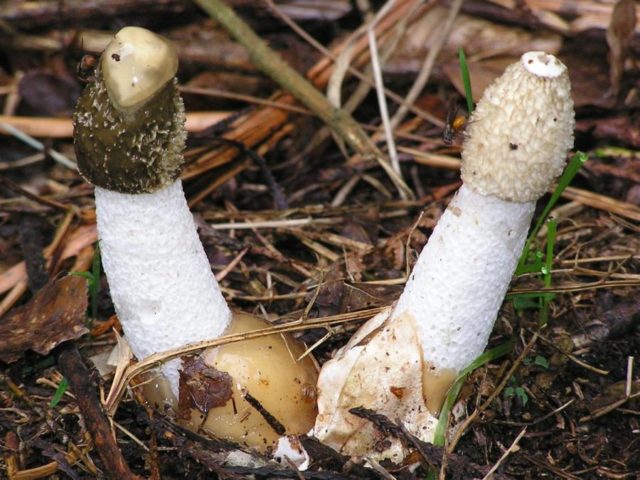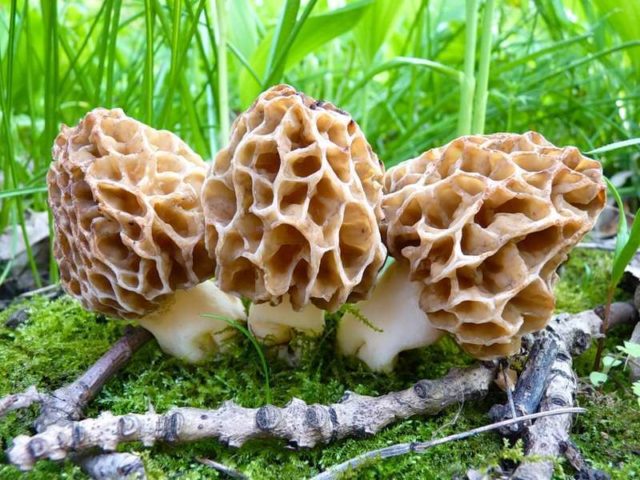Content
Veselka Ravenelli belongs to the conditionally edible representatives of the Veselkov family. The species is unique, since at a young age it exists in the stage of an egg, and in an adult - in the stage of a recipe. In order not to confuse the mushroom with inedible specimens, you need to know the external characteristics, view photo and video materials.
Where Ravenelli's fun grows
Veselka Ravenelli is a saprophytic mushroom that grows on dead wood or decaying substrate. It can be found in mixed forests, gardens, parks, open forest glades. It grows in large groups, begins bearing fruit from May to October.
What a jolly Ravenelli looks like
Veselka Ravenelli at the initial stage of development has an ovoid shape, about 5 cm in size. The surface is covered with a leathery peridium, mycelial strands extend from the wrinkled base. The egg is covered with a snow-white shell, which turns pink, lilac or lilac as it grows. With mechanical damage, the color becomes brighter and richer.
Peridium is composed of a jelly-like substance. Having ripened, the egg is opened, and the recipe for the shark, which consists of a cap and a leg, comes out of it. Also, during this period, the fungus fully matures, and the spores are carried out into the external environment.

Grows in mixed forests
The cap in an adult specimen is about 4 cm in size. The conical surface is covered with a fine-grained skin of an olive or greenish-coffee color. The upper part has a gleb - the inner pulp of the fruiting body.
The snow-white or yellowish leg is hollow, porous. The pulp is dark with an unpleasant strong aroma that attracts insects.
Is it possible to eat fun Ravenelli
Veselka Ravenelli belongs to the 4th group of edibility, is conditionally edible. In cooking, only specimens in the egg stage are used. Adults have medicinal properties, so the mushroom has found use in traditional medicine. Mushroom decoctions and infusions are used to treat visual dysfunction and rheumatic diseases.
Veselka Ravenelli, due to its unusual appearance, is surrounded by legends and beliefs:
- the species is considered a strong aphrodisiac;
- thanks to antioxidants, infusions and decoctions stop the growth of cancer cells;
- when applied externally, mushroom pulp helps to heal wounds;
- in the Middle Ages, it was believed that a man who saw a joke must eat it, otherwise he would be overwhelmed by male powerlessness;
- the mushroom grows so fast that it surpasses bamboo shoots in growth rate.
Mushroom taste
In cooking, Ravenelli's fun is used only in the egg stage. Ripe specimens exude an unpleasant odor, so mushroom pickers prefer not to collect them and not use them for food. Overripe mushrooms cause mild food poisoning when eaten.
False doubles
This representative, like any inhabitant of the forest, has similar twins. These include:
- Ordinary - an edible representative that grows on fertile soil, in mixed forests and in open places. Fruiting from May to October. In cooking, only young specimens are used. But many mushroom pickers use the species not for gastronomic, but for medicinal purposes. Infusions and decoctions are used for abdominal syndrome, impotence and cancer.
Only young specimens are used for food.
- Adriana - the species is edible both in a young and in an adult form. When used for food, it is necessary to remove the spore-containing layer, otherwise the food will turn into an unsightly color. At a young age, the mushroom has an ovoid shape; as it grows, the fruiting body bursts and the mushroom acquires a leg and a cap. The pulp is dense, snow-white, when ripe, it exudes an unpleasant odor. It grows on dead wood throughout the warm period.
Fruits during the entire warm period
- Morel edible - conditionally edible species. You can recognize him by his light coffee hat and snow-white leg. Appears in mixed forests in early spring. Pulp with a pleasant taste and a weak mushroom aroma. After preliminary boiling, the mushroom harvest is fried, stewed, harvested for the winter.
The mushroom tastes good
Collection and consumption
Collecting jokes is spent during the entire warm period. To use the mushroom for medicinal purposes, it is carefully cut with a sharp knife, and not twisted. Since the mycelium is very fragile and practically does not recover.
In cooking, only young specimens are used, when the mushroom has not yet opened and has not formed a leg and a cap. After heat treatment, the harvested crop is used fried, stewed or boiled. Also collected specimens can be dried and frozen for the winter.
Conclusion
Veselka Ravenelli is a conditionally edible representative of the forest kingdom. It grows on decaying wood in mixed forests and within the city. In cooking, young specimens are used; after a long boiling, the harvested crop is used for food in fried, stewed and boiled form. For the winter, the mushrooms are dried and frozen.











